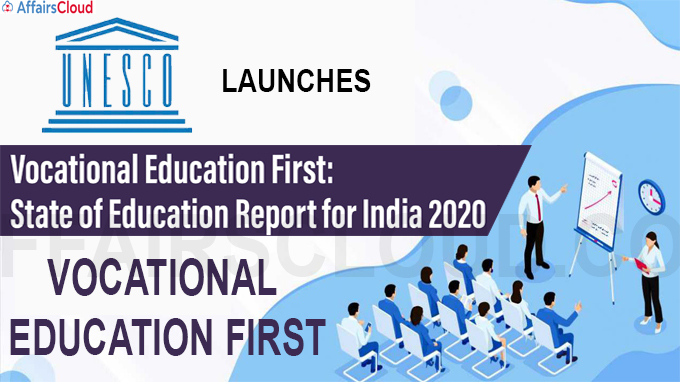 On December 8, 2020, the UNESCO (United Nations Educational, Scientific and Cultural Organization), New Delhi virtually launched the 2nd edition of “State of the Education Report for India 2020: Technical and Vocational Education and Training (TVET)”.
On December 8, 2020, the UNESCO (United Nations Educational, Scientific and Cultural Organization), New Delhi virtually launched the 2nd edition of “State of the Education Report for India 2020: Technical and Vocational Education and Training (TVET)”.
- The launch event was attended by over 300 attendees, including representatives from the government, civil society, academia, partners and youth.
- This report is an overview of the present capacity for TVET provision through short-term and long-term courses.
- It has been developed by an experienced team of researchers from the Tata Institute of Social Sciences (TISS), Mumbai, Maharashtra under the guidance of UNESCO New Delhi. It’s technical and financial partner was New York (United States) based American India Foundation (AIF).
Aim of the Report: To support the Government of India (GoI) by acting as a reference tool for enhancing and influencing the policies and programs related to skills development.
- Notably, GoI has already announced skills development as a key national priority under the Skill India Mission.
- The NEP 2020 also reflects vocational education as it sets a target that at least 50% of all learners receive vocational education by 2025.
Point to be noted:
The SDG 4 represents Quality education. As per NITI (National Institution for Transforming India) Aayog 2019 Performance of states and UT on the SDG, Himachal Pradesh is performing best in SDG 4 with a score of 81 while on complete SDG performance Chandigarh and Kerala have gained a maximum score of 70.
India’ Current Scenario:
–India made progress towards its goal of creating a skilled workforce of 110 million people by 2022, as stated in the 2015’s National Policy of Skill Development and Entrepreneurship (NPSDE). Presently, 10 million people are being trained each year across all ministries.
–In order to integrate vocational education with formal education, 25% of schools and colleges should offer vocational education courses.
–There are around 10,158 state-government-run schools that offer vocational education to over 1.2 million students in Grades 11–12 in school. This is in addition to 8,583 Central Board of Secondary Education (CBSE) schools.
— Madhya Pradesh (MP) is leading among the State government run schools offering vocationalization of secondary school education with 140384 enrolments.
–Youth unemployment in India may rise to 32.5% in 2020 amid COVID-19 containment measures as compared to 23% in 2019.
–The Central Government is skilling the youth through its number of programes including Pradhan Mantri Kaushal Vikas Yojana (PMKVY) launched in 2015 for training rural youth, National Apprenticeship Promotion Scheme (NAPS) launched in August 2016 to provide basic training and practical or on-the-job training (OJT) at the workplace. There are Jan Shikshan Sansthan (JSS) or People’s Learning Centre also, among others.
Recommendations Provided by Report:
In order to achieve evidence-based results, the Report outlines a set of ten recommendations that should be adopted to help achieve the stated vision for TVET in the country.
- Place learners and their aspirations at the centre of vocational education and training programmes
- Create an appropriate ecosystem for teachers, trainers and assessors
- Focus on upskilling, re-skilling and lifelong learning
- Ensure inclusive access to TVET for women, differently abled and disadvantaged learners
- Massively expand the digitalization of vocational education and training
- Support local communities to generate livelihoods by engaging in the preservation of tangible and intangible cultural heritage
- Align better with the 2030 Agenda for Sustainable Development
- Deploy innovative models of financing TVET
- Expand evidence-based research for better planning and monitoring
- Establish a robust coordinating mechanism for inter-ministerial cooperation
Click Here for Official Report
What is vocational education?
Vocational education or Vocational Education and Training (VET) is also called Career and Technical Education (CTE). With this, students prepare for the jobs in manual or practical activities means the jobs that are non-academic and totally related to a specific trade, and occupation.
- Sometimes it is also referred to as technical education, as the learner directly develops expertise in particular techniques or technology.
UNESCO’s Initiative:
UNESCO has developed a Strategy for TVET (2016-2021) in alignment with Sustainable Development Goal 4 and the Education 2030 Framework for Action to strengthen TVET systems of Member States and advance youth employment, access to decent work, entrepreneurship and lifelong learning opportunities in specific national contexts.
The TVET Strategy for 2016 – 2021 has three priority areas:
- Fostering youth employment and entrepreneurship
- Promoting equity and gender equality
- Facilitating the transition to green economies and sustainable societies
Recent Related News:
i.As a part of implementing the new National Education Policy (NEP), 2020, the Cabinet approved the implementation of Rs 5718 crore Strengthening Teaching-Learning and Results for States (STARS) project with a financial aid from World Bank amounting to US $500 million (approximately Rs. 3700 crore).
ii.The National Skill Development Corporation (NSDC) in partnership with American India Foundation, Dell Technologies and University of Mumbai has launched ”Project Future Ready” to equip students with career skills. The project will cover over 1 lakh students in Mumbai and Delhi-NCR, of which 60% are females.
About United Nations Educational, Scientific and Cultural Organization (UNESCO):
Director General– Audrey Azoulay
Headquarters– Paris, France




